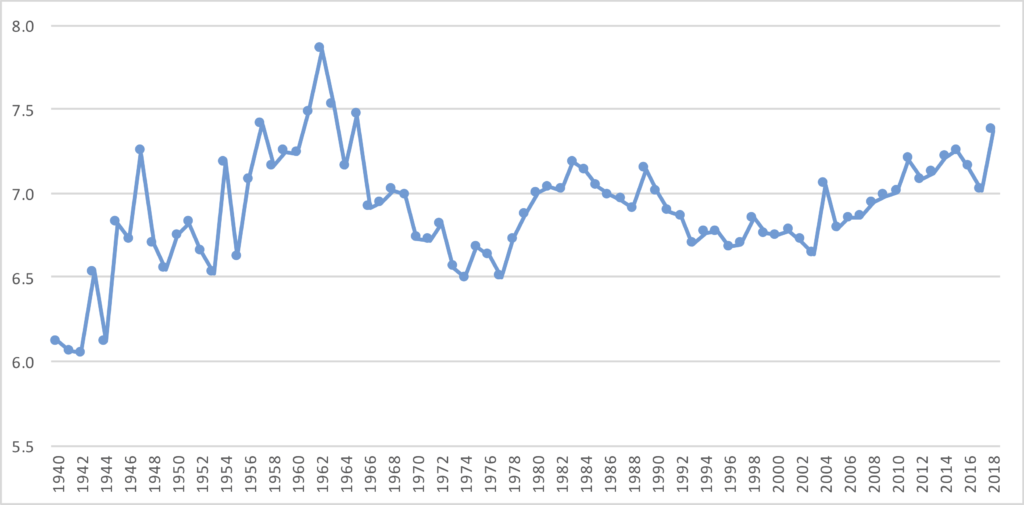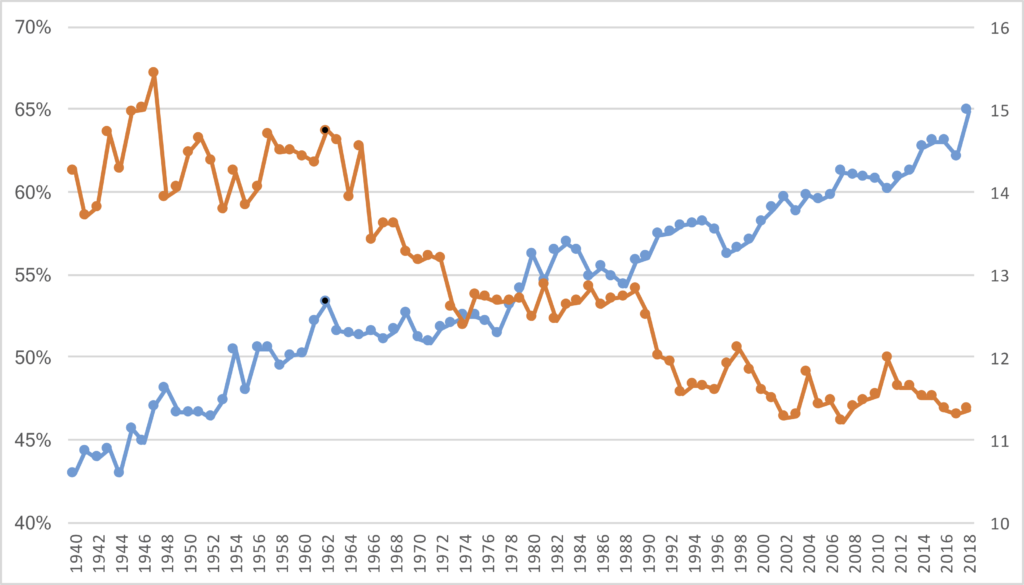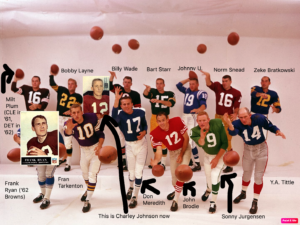It has long been established that, on average, winning teams rush for more yards than losing teams. That’s because, among other reasons, the winning team usually has the lead late in the game, causing the winning team to run more frequently and the losing team to run less frequently. Rushing attempts (and therefore, yards) are highly correlated with winning, which is one of the reasons I first started calculating Game Scripts data.
As a result, teams tend to average more rushing yards in victories than defeats. And I’m not breaking any news here when I say that this tenet holds up at the individual player level, too. From 1950 to 2018, there were 69 players who (i) rushed for at least 2,500 yards in games their teams won and also (ii) rushed for at least 2,500 yards in games their teams lost.
And 67 of those players averaged more rushing yards per game in wins than in losses. That, of course, is what you would expect. Earnest Byner is the most extreme player in this regard: in games his team won, Byner averaged 52.2 rushing yards per game; in games his team lost, Byner averaged 25.7 rushing yards per game. And it’s not just the Byners of the world: Hall of Famers with different styles and from different eras — Marshall Faulk (86.0 rushing yards per game in wins, 52.0 in losses), Earl Campbell (107.4, 63.4), O.J. Simpson (112.0, 69.3) and Thurman Thomas (77.6, 44.5) to name a few — have large splits in rushing averages in wins and losses.
But today’s post is about Byner’s teammate on the ’91 Redskins, Gerald Riggs. He is one of just two players (Don Perkins, 56.2, 59.8) in this group who averaged fewer rushing yards per game in wins (60.0) than in losses (66.2). That should be shocking to you as a reader, given that the average running back will have about 40% more rushing yards in wins than losses. So does this mean Riggs actually was a better running back when his team lost the game?
The short answer is, no. Riggs, like every other running back, rushed for more yards when his team won than when his team lost, all else being equal. It’s that last part, though, that is the tricky part.
Riggs had two dominant rushing seasons where he averaged 99 and 107 rushing yards per game: 1984 and 1985. In those two seasons, his Falcons went just 7-24 in the games he played.
Riggs had four strong seasons where he averaged between 50 and 90 rushing yards per game: 1986 to 1989. In those four years, his teams went 20-28-1 in games he played (and I will be ignoring the one tie game for the rest of this article).
Riggs also had four years — two at the beginning of his career and two at the end — where he was a backup and averaged under 50 rushing yards per game. In those four seasons (’82, ’83, ’90, and ’91) his teams went 31-18. Notably, this includes his time on the ’91 Redskins — who went 14-2 and for whom Riggs played every game — when he averaged a career low 15.5 rushing yards per game and retired after the season (after scoring a pair of touchdowns in the Super Bowl, no less).
Regular readers of this site and those familiar with Simpson’s Paradox can surely see what’s coming. During his stud running back days, Riggs played on bad teams that produced just 12% of his career wins but 34% of his career losses. During his days as a solid starter, Riggs played on teams that produced 34% of his career wins and 40% of his career losses. And during his days as a backup, Riggs played on good teams that produced 53% of his career wins and just 26% of his career losses. His time as the third-string running back behind Byner and Ricky Ervins on one of the best teams of all time produced 24% of his career wins but just 3% of his career losses.
So when we look at his career, of course Riggs rushed for more yards in losses than in wins: broadly speaking, he was a reserve in a lot of the games his team won and the center of the offense in many of the games his teams lost.
In 1984, Riggs rushed for 99 yards per game on a 3-12 Falcons team in the games he played. In Atlanta’s three wins, he rushed for 137 yards per game; in the 12 losses, he averaged 90 rushing yards per game. That’s perfectly normal, rushing for significantly more yards per game in wins than losses.
In 1991, Riggs rushed for 16 yards per game on maybe the best team of all time. In wins, he rushed for 17 yards per game, and in losses, he rushed for 2 yards per game. That’s perfectly normal, too: rushing for significantly more yards per game in wins than losses.
But here’s the catch: what if we remove the ’84 and ’91 seasons from Riggs’ career entirely? By removing two years where Riggs rushed for significantly more yards per game in wins than in losses, what happens to his career average? Well, it would mean Riggs would have rushed for 69 yards per game in wins and … 63 yards per game in losses. This, of course, is the heart of Simpson’s Paradox: because of the different sizes of the groups, the results are reversed when we combine the data. It’s counter-intuitive, because Riggs looks better for his career in wins than in losses only after we remove two years where he did much worse in wins than in losses!
The table below shows Riggs’s career stats by season, and his per-season rushing statistics in wins and losses. The final right column shows how many more rushing yards per game Riggs averaged in losses than in wins each year. As you can see, while this number is a positive 6.2 for his career, in all but two seasons, this number was negative, meaning Riggs averaged more rushing yards per game in wins than losses:

This is what Simpson’s Paradox is all about, and this may be my new favorite example: the 1991 season really deflates his career averages, but it hits his “wins” statistics 8x as powerfully as his “losses” statistics.
And there’s even an easy story to tell about his 1989 season, which looks like a big outlier. After all, Riggs averaged a mediocre 50 rushing yards per game in wins and a superstar-producing 108.5 yards per game in wins. So what happened? In week 2, Riggs rushed for a whopping 211 yards in a win against the Eagles…. except it wasn’t a win; the Redskins led 20-0 early and 37-28 with less than three minutes left in the game, but the Eagles scored two last-minute touchdowns to steal the game and turn this into a great rushing effort in a loss (in part because of Riggs’ game-changing fumble). Had this been a win, Riggs would have averaged 69.0 rushing yards in wins that season, and 71.0 rushing yards per game in losses. And that is only because Riggs lost playing time as the season went along: he was a part-time player by December, when Washington went 4-0 but Riggs averaged only 41 rushing yards per game.
The general rule is that all players average more rushing yards in wins than in losses. And when that’s not true, well, it probably still is true: you just need to figure out how Simpson’s Paradox is mucking up your data.










